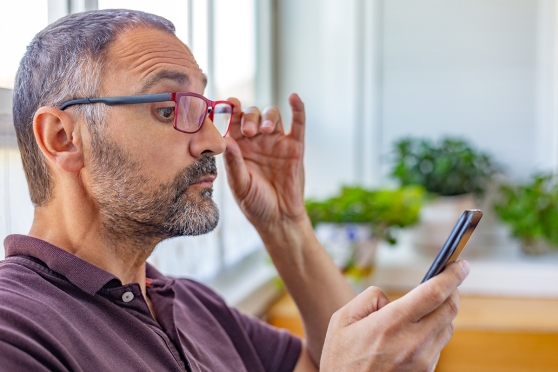Why people with diabetes may need sunglasses
Sunlight may be harmful to the eyes — especially for people with this condition. Here’s what to know.

It might be a good idea for anyone to wear sunglasses when it’s sunny outside. But sunglasses may be even more important for people with diabetes.
That’s because potentially harmful ultraviolet (UV) rays from the sun could contribute to — or possibly worsen — certain diabetes-related eye conditions.
Read on to find out why it may be important for people with diabetes to wear sunglasses, and how they might pick the right pair.
Stay on top of your eye health with an in-network provider. Search for an eye care provider now.
How ultraviolet (UV) light might affect a person’s eyes
There are 2 types of UV light from the sun — UVA and UVB. Both may damage a person’s eyes if they’re exposed to it for too long. UVB rays, for instance, may cause something called snow blindness, or a sunburn on a person’s cornea (the outer layer of the eye), which may cause a temporary loss of vision.1
But the sun’s rays may not just affect the cornea. “Every layer of an eye can be affected and get damaged by UV sun exposure,” says Ryan Bulson, O.D. He’s an optometrist and professor in the college of optometry at Pacific University in Forest Grove, Oregon.
According to the U.S. Environmental Protection Agency (EPA), research has shown that UV light may increase a person’s chances of developing cataracts (cloudiness in the vision) and macular degeneration (an issue with the retina, or the tissue at the back of the eye).2
How people with diabetes might be affected by ultraviolet (UV) light
People who have diabetes may be at risk of developing diabetic eye disease, a group of eye issues that may include:3
- Cataracts
- Diabetic macular edema (a condition that may cause vision issues or blindness in people with diabetes)
- Diabetic retinopathy (a condition that may cause vision loss or blindness in people with diabetes)
- Glaucoma (an eye disease that may cause vision loss or blindness)
If a person already has one of those diseases, they may need to be aware of the effects of UV rays on their eyes. “People who are diabetic and have more UV sun exposure have higher rates of damage to the retina and diabetic eye diseases such as retinopathy,” says Dr. Bulson.
Diabetic retinopathy is a complication that may occur from a person’s blood sugar being too high over time. It may affect the blood vessels in the retina, causing them to potentially leak fluid or bleed which may affect a person’s vision.4
Regular exposure to UV light may also cause diabetic macular edema (DME), according to the American Diabetes Association. That’s a condition in which there may be excess fluid in the back part of the retina.5 UV rays may also cause DME to get worse and may cause it to develop in people who have had cataract surgery.6
Dr. Bulson says there may be other ways UV light could affect the eyes of people with diabetes as well. He notes that UV light could:
- Damage the lenses in a person’s eyes. This could cause (or worsen) cataracts, which may show up earlier in people with diabetes.
- Make dry eye worse. People with diabetes may have a higher chance of getting dry eye than most.
- Increase a person’s risk of macular degeneration. That’s an issue with the retina.
How a person with diabetes might choose a pair of sunglasses
Since people with diabetes may have an increased risk of diabetic eye disease, wearing sunglasses may assist with keeping their eyes healthy. Not all sunglasses may work though. Here are 3 potential tips to help make a person’s choice easier:
Tip #1: Pick sunglasses that may offer full UV protection.
People will want to ensure that their sunglasses block the sun’s UV rays. They may find them online or even over the counter.
“Most sunglasses do block all UV light, but make sure there’s a sticker on the lens that indicates they block 100% of all UV light,” says Dr. Bulson. The label may say “UV400” instead, which provides the same amount of protection.7
“If you don’t get a pair of sunglasses with 100% UV protection, it’s actually a serious problem because you’re potentially getting more UV light exposure to the sensitive parts of your eye,” says Dr. Bulson. “The pupil may be more dilated behind the sunglasses, causing more UV light to reach your cornea, lens and retina.” (The pupil is the round opening in the center of the iris, the colored part of the eye, through which light passes.)
Tip #2: Pick sunglasses that have larger lenses and frames.
People may want to choose sunglasses with larger lenses and frames, says Dr. Bulson. “The larger the frame, the more protection for the structures of the eye.” Plus, larger lenses may help people protect the skin around their eyes, including their eyelids, he adds. Wraparound sunglasses may also help protect the skin around the eye.
Tip #3. Pick sunglasses that may reduce glare.
Although anti-glare or polarized sunglasses may help protect eyes from glare, that may not mean they’re 100% UV-blocking, says Dr. Bulson. “Though typically a polarized lens will block UV rays, a pair of polarized glasses isn’t one and the same,” he explains.
These types of lenses may help a person who is boating, fishing or swimming in water. They may also help reduce glare for people with diabetes who are driving, especially at night.
That’s because diabetic retinopathy, macular degeneration, cataracts and glaucoma may all contribute to night blindness.8 Also called nyctalopia, that issue may make it difficult or impossible to see at night.
Providers in the UnitedHealthcare Vision Network are here to help keep your vision healthy. Search for a provider now.
Sources:
- Ultraviolet (UV) radiation and sun exposure United States Environmental Protection Agency, last updated July 2023.
- Health effects of UV radiation United States Environmental Protection Agency, last updated February 2024.
- Diabetic eye problems MedlinePlus, last updated December 2023.
- At a glance: Diabetic retinopathy National Eye Institute, February 2024.
- Diabetic macular edema American Academy of Ophthalmology, November 2023.
- Eye health: Which sunglasses are best for people with diabetes? American Diabetes Association, June 2023.
- Tips to stay safe in the sun: From sunscreen to sunglasses U.S. Food and Drug Administration, May 2024.
- Low vision National Eye Institute, last updated November 2023.


